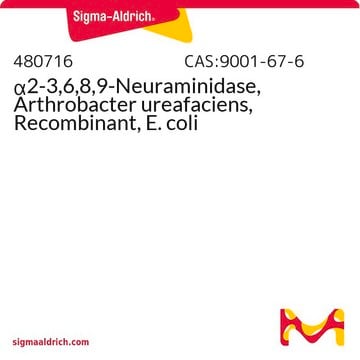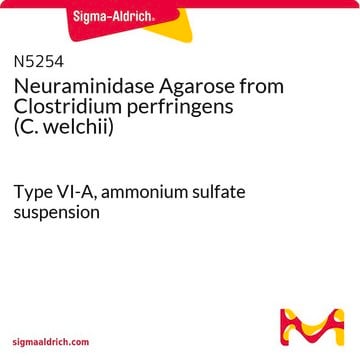10269611001
Roche
Neuraminidase (Sialidase)
from Arthrobacter ureafaciens
Synonyme(s) :
PCR, taq
Se connecterpour consulter vos tarifs contractuels et ceux de votre entreprise/organisme
About This Item
Produits recommandés
Source biologique
bacterial (Arthrobacter ureafaciens)
Niveau de qualité
Forme
solution
Activité spécifique
~25 units/mg protein
Conditionnement
pkg of 1 U (100 μl)
Fabricant/nom de marque
Roche
pH optimal
5.0-5.5
Température de stockage
2-8°C
Catégories apparentées
Description générale
Neuraminidase hydrolyzes terminal N- or O-acylneuraminic acids which are α2,3-, α2,6-, or α2,8-linked (rate: α2,6 > α2,3 > α2,8) to oligosaccharides, polysaccharides, mucopolysaccharides, glycoproteins, and glycolipids. Noteworthy, for the hydrolysis of glycolipids, the presence of a detergent is necessary. Because of the broad substrate specificity, the enzyme is very well suited for the complete removal of sialic acids from glycoconjugates of a wide variety of biological materials.
Spécificité
Cleaves terminal sialic-acid residues that are α2,3-, α2,6-, or α2,8-linked to Gal, GlcNAc, GalNAc, AcNeu, GlcNeu, oligosaccharides, glycolipids, or glycoproteins. Relative rate of cleavage is α2,6 >α2,3 >α2,8, determined on bonds in tri- and tetrasaccharides.
Application
- cell surface lectin array analysis.
- hemagglutination assays.
- cell adhesion assay.
For the hydrolysis of glycolipids, the presence of a detergent is necessary. Because of the broad substrate specificity, the enzyme is very well suited for the complete removal of sialic acids from glycoconjugates of a wide variety of biological materials.
Neuraminidase has been used for the:
- detection of the cell surface glycosylations in human anaplastic large cell lymphoma cells
- release of sialic acid from cells
- antibody-overlay lectin microarray
Propriétés physiques
This product is a mixture of isoenzymes (L, M1, M2 and S) with the following molecular weight values: ~ 52 kDa, 66 kDa and 88 kDa.
Forme physique
Solution in 10 mM sodium phosphate, 0.1% Micr-O-Protect (w/v), 0.25 mg/ml bovine serum albumin, pH 7
Notes préparatoires
Working concentration: Enzyme/substrate ratio should be in the range of 0.04 U/25-80 μg.
Autres remarques
For life science research only. Not for use in diagnostic procedures.
Mention d'avertissement
Warning
Mentions de danger
Conseils de prudence
Classification des risques
Skin Sens. 1
Classe de danger pour l'eau (WGK)
nwg
Point d'éclair (°F)
does not flash
Point d'éclair (°C)
does not flash
Faites votre choix parmi les versions les plus récentes :
Déjà en possession de ce produit ?
Retrouvez la documentation relative aux produits que vous avez récemment achetés dans la Bibliothèque de documents.
Les clients ont également consulté
Charting the Proteoform Landscape of Serum Proteins in Individual Donors by High-Resolution Native Mass Spectrometry.
Cramer, et al.
Analytical Chemistry, 94, 12732-12741 (2022)
Tomonori Kaifu et al.
The Journal of experimental medicine, 218(12) (2021-11-25)
Dendritic cell immunoreceptor (DCIR) is a C-type lectin receptor with a carbohydrate recognition domain and an immunoreceptor tyrosine-based inhibitory motif. Previously, we showed that Dcir-/- mice spontaneously develop autoimmune enthesitis and sialadenitis, and also develop metabolic bone abnormalities. However, the
Cellular entry of the porcine epidemic diarrhea virus
Li W, et al.
Virus Research, 226, 117-127 (2016)
Sialylation by ??galactoside ??2,6?sialyltransferase and N?glycans regulate cell adhesion and invasion in human anaplastic large cell lymphoma
Suzuki O, et al.
International Journal of Oncology, 46(3), 973-980 (2015)
Jiaqi Wu et al.
BioTechniques, 68(2), 85-90 (2020-01-16)
Carbohydrate-deficient transferrin (CDT) is a reliable biomarker for chronic alcohol abuse. We developed a method for CDT analysis by capillary isoelectric focusing, followed by immunodetection directly in the capillary, in an automated fashion and on a single platform (Peggy Sue™;
Protocoles
Neuraminidase can be used to cleave sialic acids from proteins. In this protocol, the enzyme from Vibrio cholerae is used on fixed cells.
Notre équipe de scientifiques dispose d'une expérience dans tous les secteurs de la recherche, notamment en sciences de la vie, science des matériaux, synthèse chimique, chromatographie, analyse et dans de nombreux autres domaines..
Contacter notre Service technique







